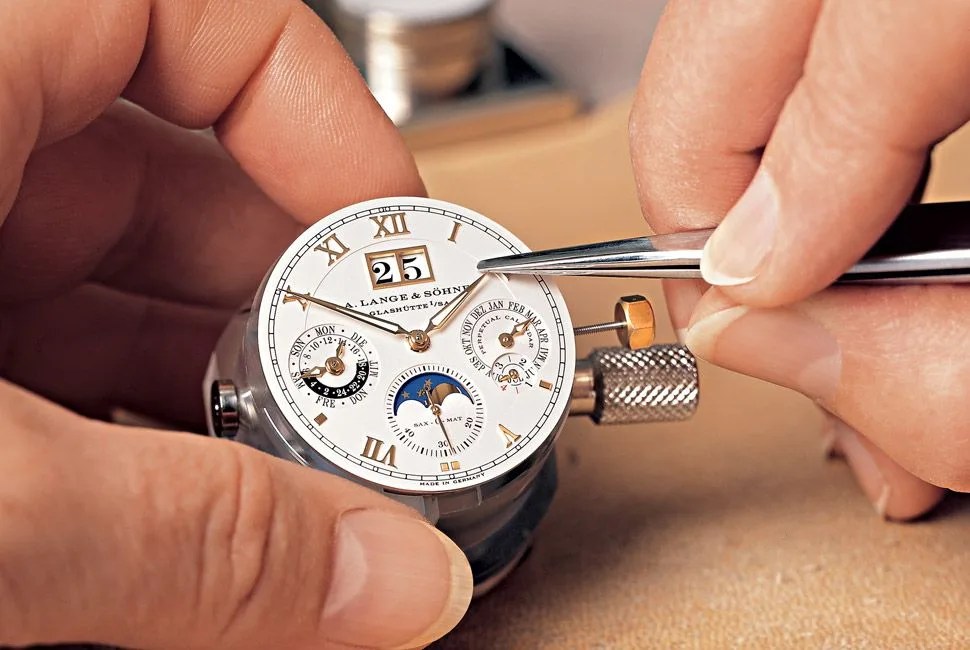I’ll never own a Lange & Söhne timepiece. The choice I made to become a watch journalist pretty much sealed that fate. Langes adorn the wrists of celebrities and CEOs, corrupt politicians and trust fund recipients, not writers hustling for their next month’s assignments. Anyway, my personal tastes run to the more brutish timepieces — divers and pilot’s watches, those I can enjoy abusing underwater and on mountaintops. I’m not a “dress watch” guy, and Langes are decidedly dressy.
MORE LANGE: Video: Saxon Snow | Datograph Up/Down | Grand Lange 1 Lumen
Yet ask me what my favorite watch brand is and I’ll tell you “A. Lange & Söhne” without hesitation. There are a lot of storied old watch brands out there, most of them in Switzerland, some I have visited. Many of them hand decorate their movements, invent stupendous complications and have great histories. But for a so-called luxury brand, Lange has an underdog story that humanizes the company more than most others: a long and respected history, bisected by wars, both hot and Cold, bookended by the family heir’s triumphant return to his home to restore his business and breathe new life into a downtrodden town. You could almost not script it better.
Back in 2010, when I was just dipping a part-time toe into watch journalism, I got an offer to visit the A. Lange & Söhne factory. At that time I had only reviewed a handful of dive watches, was still years away from going to SIHH or BaselWorld, and scarcely knew a hairspring from a mainspring. Yet there I was being whisked in a black Audi through the dark wooded ravines that wind along the Müglitz River, to arrive in the hamlet of Glashütte at the gates of the magical Lange compound. How could I have known where things would lead from there, a greenhorn writer about to enter the place where the world’s finest watches are made? I had the golden ticket in my hand and I didn’t even know it yet.
While Switzerland has a long uninterrupted history of high watchmaking, Glashütte’s was stunted for half a century by an oppressive Communist regime.
Visiting Lange on my first watch factory tour was like a kid being brought to the Balvenie distillery to celebrate his 21st birthday. I was ruined forever. Every other watch I laid eyes on afterwards was held to the standard of those that are hand-beveled, engraved and assembled in those sunlit rooms in Saxony. Though it was my first visit to a watch manufacture, I knew I was seeing something special. It wasn’t just the ornate decoration or complicated movements that made an impression on me. Glashütte knew hardship and had come out the other end to build some of the most luxurious and expensive timepieces in the world.
Saxony, where Glashütte is situated, is still considered by many Germans to be a sort of poor cousin, or “flyover country” in more American parlance, due to its drab architecture and rural landscape. While Switzerland has a long uninterrupted history of high watchmaking, Glashütte’s was stunted for half a century by an oppressive Communist regime. On a recent trip there, I toured the beautiful “Uhrenmuseum” which traces the history of watchmaking in the town, from the 1800s up through the present day. While today most people think of luxury timepieces from this place, an entire room of this museum is dedicated to the cheap wristwatches that Glashütte watchmakers were forced to build for the Communist-run watch conglomerate. Perhaps that’s why its residents, the majority of whom work in the watch industry, work a little bit harder and talk a little bit less. As a Midwesterner, I could relate to that.
That trip to Lange four years ago instilled an appreciation for watchmaking in me that I’m not sure I would have otherwise. It’s not an understatement to say that my visit there changed my life. I’m now writing about watches full time, going to Basel and SIHH, and I know my hairspring from my mainspring. I’ve been back to Glashütte three more times since that first visit. When I’m asked what it is I find so fascinating about watches, or what makes a fine mechanical watch so much better than, say, the new Apple Watch, I wish I could transport the person asking to Glashütte and lead them by the hand through those workshops. But I can’t. So I write about watches, hopefully with a level of care and love for the craft that approaches what I witnessed in those Lange workshops. If I’m successful, they’ll understand. I know they will. I did.
